Honey Bee swather expands cropping options for Hants grower
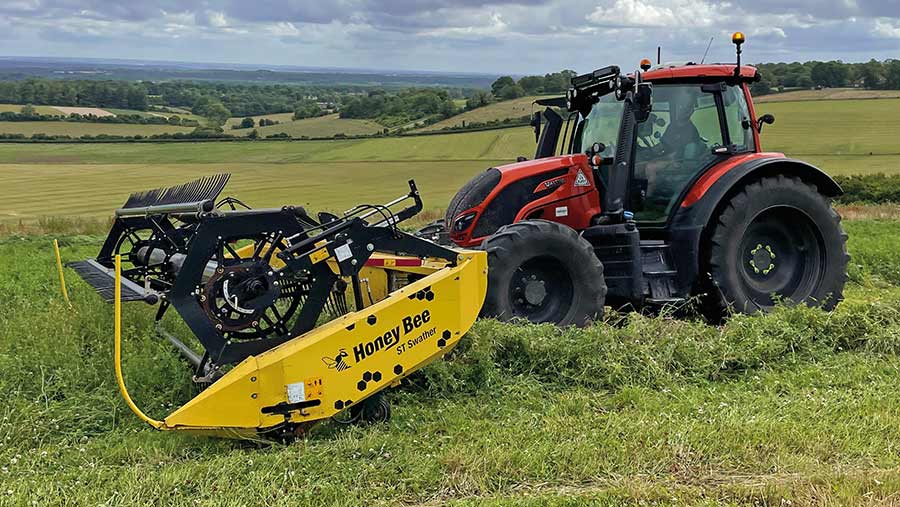 © James Andrews
© James Andrews Once a popular tool for pre-harvest management, the self-propelled swather has been slowly sidelined in favour of running through with a sprayer to deliver a shot of glyphosate.
The attraction of the chemical technique is that it’s quicker, cheaper and means there’s one less machine to buy and maintain, or one less service to draft in from a contractor.
But for organic growers and those looking to reduce their reliance on agrochemicals, the swather is still the only reliable method of getting back some control at harvest.
Plus, if glyphosate is ever banned, they will become the sole option for all growers.
See also: Buyer’s guide to direct-cut wholecrop headers
The decline of these machines means there’s a shrinking pool of second-hand models to choose from, and the limited number of options available to buy new have list prices north of £200,000.
That means they’re only really suited to large arable enterprises and contractors.
However, there is a cheaper solution, in the form of swather headers that can be mounted on a tractor’s front linkage, or rear if it’s a model equipped with reverse drive.
One such option is the Honey Bee ST, which is brought into the UK by importer Amia. It is essentially one of the firm’s combine draper headers, adapted to mount on a three-point linkage and fitted with its own hydraulic system.
The firm has three models working on UK farms at present, one of which is owned by Hampshire organic farmer Tim May.
He has been running a 6.4m (21ft) version on his 1,000ha farm, Kingsclere Estates, for the past three years, which he’s used to swath a host of crops from spring barley and oats, to lucerne and quinoa.
He’s also been offering a contracting service, which has gone from strength to strength and added crops such as grass seed, borage and camomile to its workload.
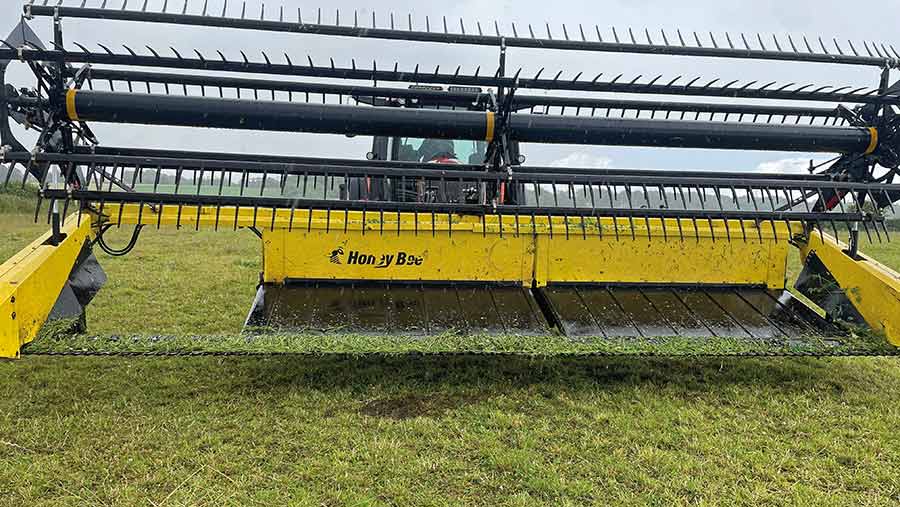
© James Andrews
Tricky harvests
Mr May’s decision to get into swathing was borne out of necessity.
Over the past few years, he has been experimenting with undersowing and companion cropping, which has brought many benefits, but made harvests increasingly challenging.
Matts of green in the bottom of the crop have made it difficult to cut and feed into the combine and, after one particularly tough year, he decided to do something about it.
His solution was to buy a trailed 7.6m (25ft) MacDon swather and Shelbourne Reynolds combine pick-up header, which allowed him to cut crops early and leave them to dry for a few days before collection.
This approach transformed his harvests, meaning he could plan and set rough dates when each crop would be brought in, and avoid time-consuming blockages.
It was a winning formula, but the trailed MacDon was clumsy to use, only had a single knife drive and required driving on the crop to open the field up.
That’s when he spotted Honey Bee’s ST tractor mounted swather working in France.
This hooks to the tractor’s front linkage, so it can be driven straight into a field and start cutting, without having to run the tractor’s wheels in the crop.
It also has a double knife drive, which offered the prospect of better cutting in green crops.
At the time, ST swathers weren’t being imported into the UK, but Mr May managed to get a demonstration model sent over and was impressed enough to buy one.
He opted for the 6.4m (21ft) version with adjustable draper belts, which set him back about £52,000 three years ago.
The firm also makes a smaller 4.6m (15ft) model with single swath table, and three larger models up to 10.9m (36ft).
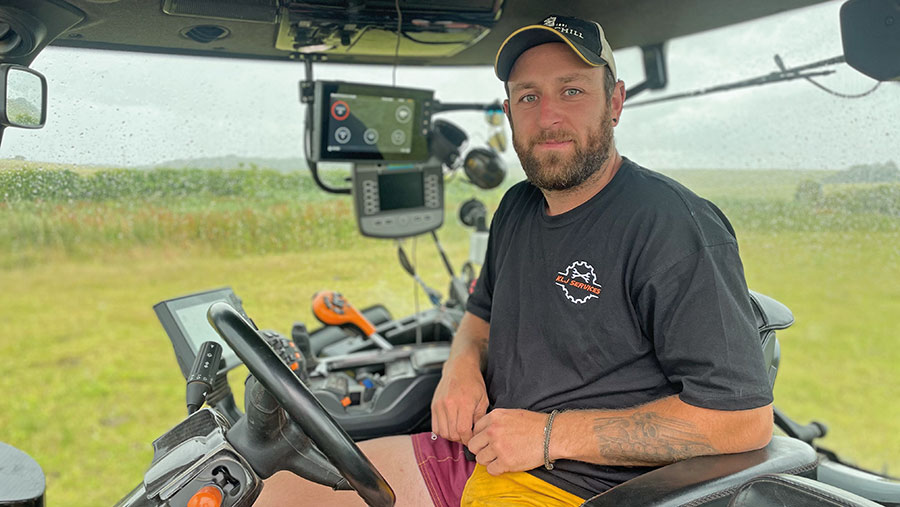
Operator Kevin Brawn © James Andrews
Driving it
The ST swather mounts to the front linkage of the farm’s four-cylinder Valtra N174 and has its own pto-powered hydraulic system to run the Schumacker double knife drive and twin draper belts.
That leaves just the reel rotation, plus fore-aft and height adjustment, to run off the tractor’s spool valves.
One spool came as standard on the front of the tractor and additional services were run from the back end via extension hoses.
Most of the time, the swather is piloted by driver Kevin Brawn who has cut thousands of acres with it in several different crop types.
Typically, he cuts the headland with the draper belts set to put the swath into the centre, but when he gets into the body of the field, he shunts the belts across – this can be done hydraulically from the cab – so that the swath discharges to the side of the tractor.
This removes the problem of bulky crops getting snagged as they pass under the tractor, but also allows him to place two rows adjacent to one another.
This double row is just the right size to fit into the Shelbourne Reynolds pick-up fitted to the farm’s John Deere S690i combine, meaning they can gather 12.8m (42ft) of crop in a single pass.
Because the dual swath is just the right width for the pick-up, they need to cut using GPS, otherwise there’s a risk some of the crop will spill out of the sides.
Crops such as lucerne that are destined for round baling are cut with the beds set to discharge to alternate sides of the tractor so that it lays down single rows with plenty of room for the tractor to pass without running on any crop.
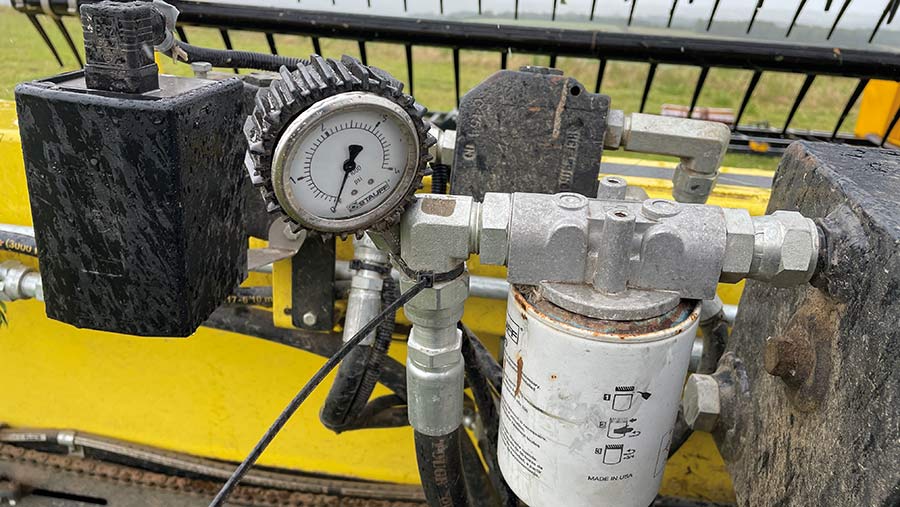
© James Andrews
Guesswork
One of the challenges of using the swather is that the knife isn’t visible from the tractor seat, meaning some guesswork is required to keep it running properly.
“The most important thing is to keep an eye on the knife drive pressure gauge, because when this starts to rise it shows that the knife is blocking,” says Mr Brawn.
“There are also other clues to help show what’s going on, such as the reel slowing when there’s a lump of crop on the bed and the state of the stubble showing if you’ve got any broken sections or soil build-up.”
Working speeds vary according to crop thickness and type, but Mr Brawn says it’s possible to cruise along at 7kph or more when it’s going well.
It’s relatively easy to handle at these speeds thanks to gauge wheels fitted on either side of the header to prevent it digging into the ground.
The whole table also floats on leaf springs so that it follows ground contours and rides over lumps and bumps.
Honey Bee has worked hard to keep the weight down on the header, using aluminium in the construction of the reel and polyurethane for the tines and spacers.
It tips the scales at 1,905kg, which makes it manageable for the four-cylinder Valtra. However, Mr Brawn fits an 850kg counterweight on the rear linkage to help balance the rig out.
For swift moving between fields, Mr May and Mr Brawn fashioned a custom bed for carrying the swather that can be picked up by a hook-lift trailer.
This avoided the need to buy a separate header trailer and it has the benefit of twin storage lockers for carrying spares.
Breakdowns
Considering the swather’s workload, there have been relatively few breakdowns – just a couple of hydraulic niggles and a broken knife, which sheared when pushing it hard cutting grass seed.
There has been one modification though, which was to replace the plastic wear bar under the knife with a mild steel version.
“The original was quickly wearing thin and the hope is that the mild steel version will last considerably longer,” says Mr May.
“As it’s from North America, all the bolts are imperial, so we’re also gradually going through and changing them to metric,” he adds.
The swather is giving Mr May the confidence to experiment with other unusual cropping regimes, such as buckwheat with canary grass, camelina with lentils and possibly wheat with linseed; the hope being that the wheat will give some support and prevent the linseed becoming pasted to the soil when it’s ready to harvest.
Other swathing options
MacDon M1170NT5
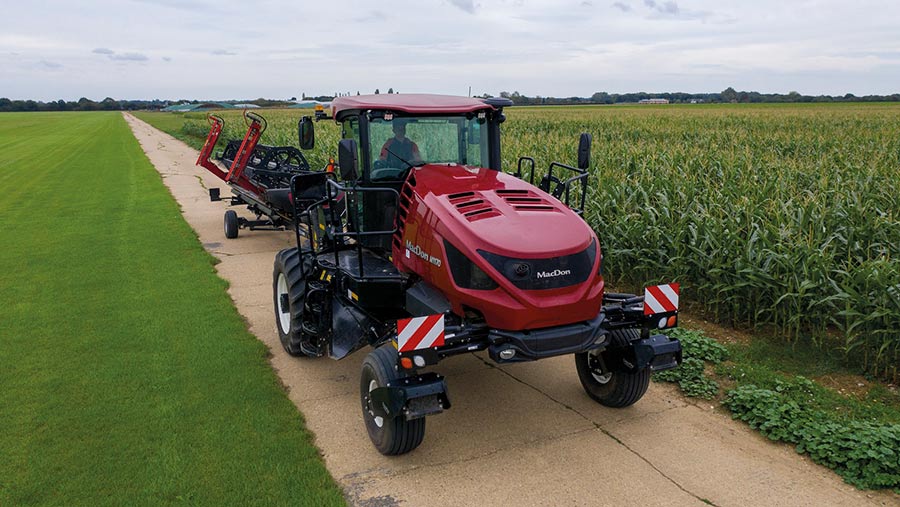
© MacDon
MacDon’s core swathing product for the UK market is its self-propelled M1170NT5, which has a sub-3.5m transport width that makes it suitable for travelling on our roads.
This is possible thanks to the presence of hydraulic adjustable track width that can be pushed out to 3.82m in the field and reduced to 3.46m for the road..
Operators can also swivel the seat to drive the swather on the road with the turning wheels at the front and the header hooked on a trailer at the rear.
The tractor unit features a 173hp four-cylinder Cummins engine that meets Stage 5 emissions limits and features a dual radiator design that draws in clean air from behind the cab to help keep it running cool.
This is teamed with a hydrostatic transmission that allows speeds of up to 29kph in the field and 45kph on the road.
To help smooth out the ride, M1 machines are fitted with a so-called Crossflex suspension system on the castor wheels that irons out bumps.
The M1 can be paired with MacDon’s range of D1 draper headers, which feature 127cm deep belts, hydraulic deck shifting and a double knife drive.
Operators are treated to a suspended cab with gas shock absorbers and stabilisation to prevent cab roll.
Inside, it is furnished with a high-back leather vented and heated seat, auto climate control, and a Bluetooth radio.
There’s also a 7in screen for setting the machine up and monitoring performance, as well as a joystick with a bank of buttons for controlling all the main functions.
List price for the M1170NT5 with a 7.6m (25ft) D125 header is €272,308 (£230,515).
MacDon TM100
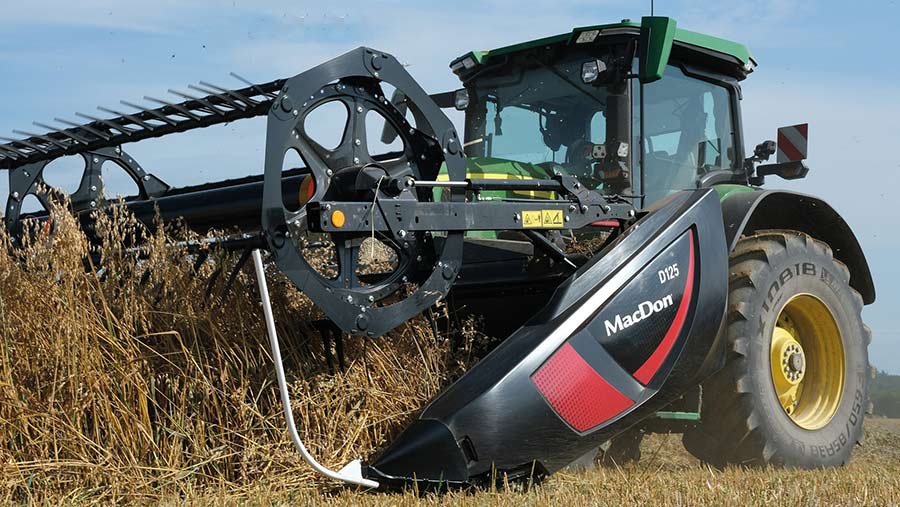
© MacDon
The TM100 is MacDon’s tractor-mounted offering, which is essentially a D1 draper header adapted to fit on the front of the tractor.
It’s a considerably cheaper option than the firm’s self-propelled machines, but offers a lower output and isn’t designed to work with such bulky crops.
Three sizes are available – 4.6m, 6.1m and 7.6m – all of which feature a double knife drive and sprung suspension system to help them ride over rough ground.
The smallest model only has the option to produce a central swath, but the 6.1m version offers manual deck shifting so that swaths can be deposited to the side.
This function is hydraulic on the largest model, meaning operators can switch the position from the comfort of the tractor seat.
A simple control box in the cab is used to adjust reel position, draper shifting and speed of the draper belts. here’s also a header tilt function that allows the angle of the bed to be adjusted to give better cutting and feeding.
Power requirements for the TM100 are a 40hp front pto and 57-litre-min hydraulic pump. List price with a 7.6m (25ft) D125 header is €85,492 (£72,371).
Talleres Tort
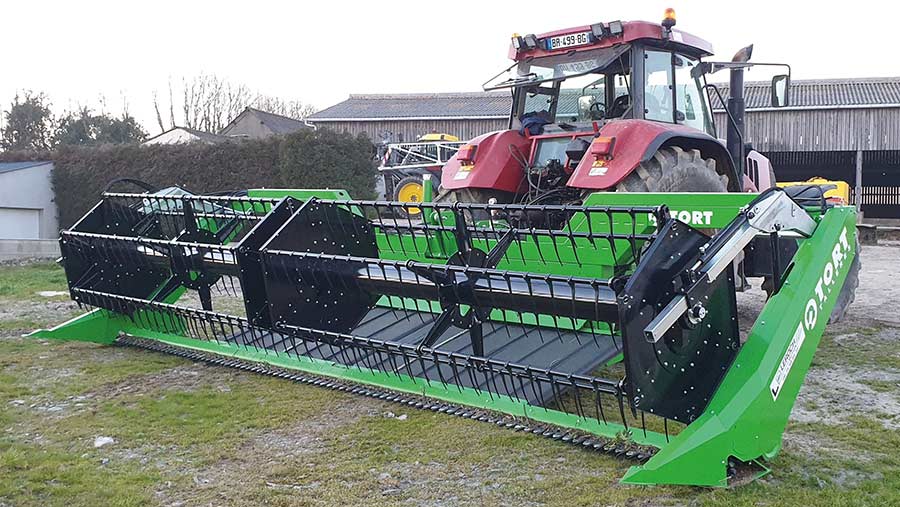
© Le Roch
French distributor Le Roch offers a tractor-mounted swather in the form of the Tort Swather from Spanish firm Talleres Tort.
The outfit is designed to be carried on the front linkage of a tractor, or on the rear for models with a reverse drive system, and it’s available in working widths from 4.5m to 7.5m. It is also possible to rig the kit to run on a forager or combine.
Buyers have the option of up to three movable belts that allow the swath to be laid in the centre of the tractor or to either side.
The belts, side knives and cutterbar run from the tractor’s pto drive, with reel adjustment via a quick-coupling hydraulic system, which uses two double-acting and one single-acting spool.
Ground-running wheels at either end of the header help to follow ground contours and there’s a nitrogen accumulator to provide a degree of suspension.
The company is on the lookout for UK distributors.

